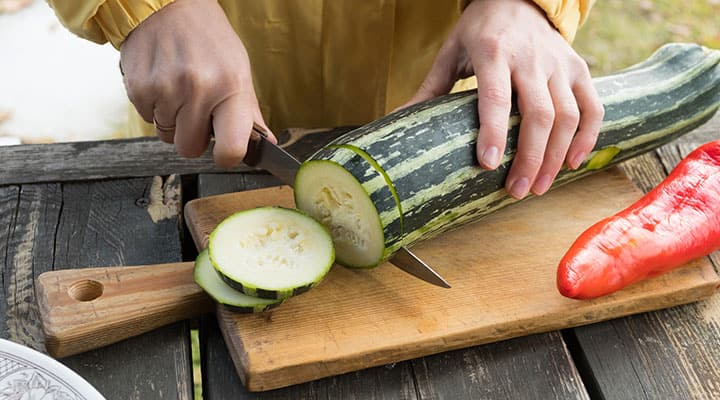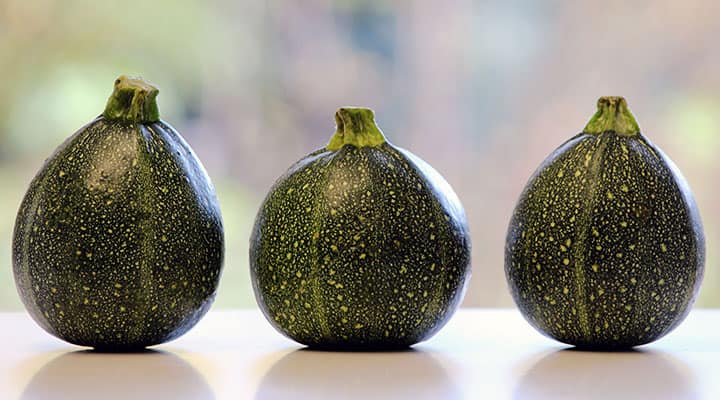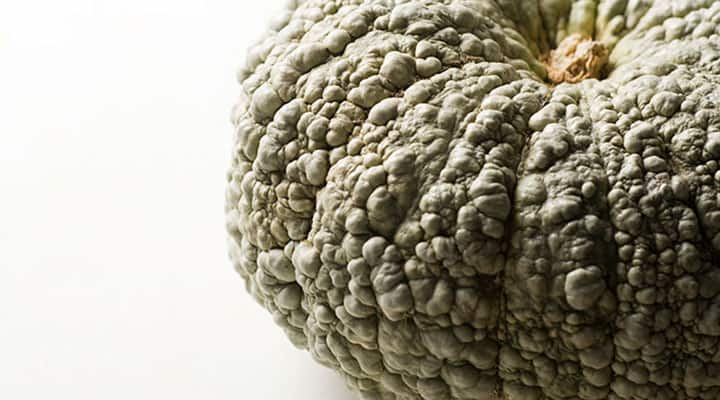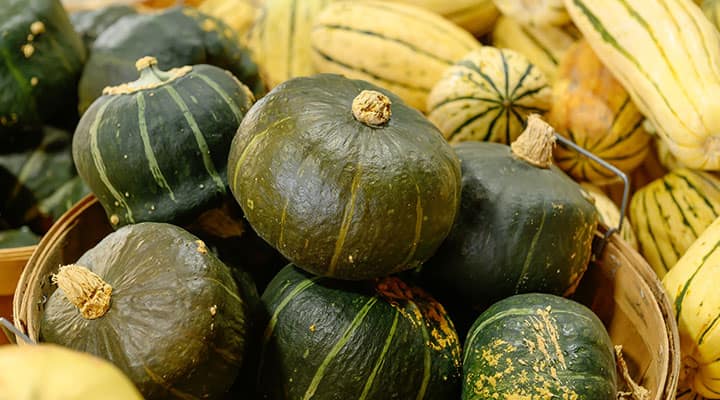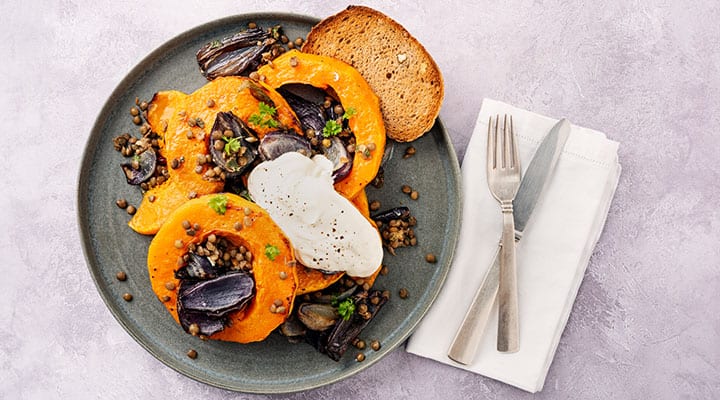
29 Types of Squash: The Ultimate Buying Guide
Published: October 2024
Squash is one of the most versatile and nutritious vegetables you can add to your shopping list! Whether you're roasting, grilling, or whipping up a cozy soup recipe, there's a type of squash perfect for every dish. Plus, squash comes packed with vitamins, antioxidants and fiber, making it a great addition to a balanced diet with particular benefits to eye health.
There are dozens of squash varieties to choose from, and they can range from nutty and sweet to dense and fleshy. Let's explore the different types of squash and how they can be a valuable asset to your health.
What are the benefits of eating squash?
Squash is a nutrient powerhouse! Most types are rich in vitamins A and C, which support or help maintain immune health, eye health, and healthy skin. Plus, squash is high in fiber, which aids digestion and helps maintain healthy blood sugar levels. Its antioxidant properties support a healthy inflammatory response and maintain healthy cells.
And since squash is low in calories but nutrient-dense, it is a great addition to support your weight management goals.
Provides vitamins A and C:
For immune function and more, go for the gourds!High in fiber:
Aids digestion and helps maintain healthy blood sugar levels, supporting gut health and satiety.Antioxidant properties:
Contains beta-carotene and other antioxidants that maintain healthy cells and may support oxidative stress responses in the body.Low in calories, nutrient-dense:
Squash provides essential nutrients without excessive calories.Supports heart health:
Fiber, potassium, and magnesium found in squash help promote cardiovascular health.Promotes healthy skin and eyes:
The beta-carotene content in squash is converted to vitamin A, which supports vision and skin vitality.
Now that you know about the "gourdness" of these nutritious vegetables, which ones do you want to enjoy for dinner? The answer to this question (if you shop in-season produce, which I recommend) depends on the time of year. Squash falls into two main categories: summer and winter.
Types of summer squash
1. Zucchini
Zucchini is the star of the summer squash family—mild, versatile, and perfect for stir-fries, salads, and baking. It's low in calories, high in water content, and loaded with antioxidants and vitamins C and A, making it a light and refreshing addition to any meal.
2. Round zucchini
Enjoy all the benefits of traditional zucchini but in an adorable spherical shape that makes it perfect for stuffing.
3. Golden zucchini
A yellow version of the classic zucchini, with a slightly sweeter flavor, this variety is not the same thing as yellow squash (see below), though it's easy to see why you could get confused!
4. Yellow squash
Yellow squash, either crookneck or straightneck, has a mild flavor and tender texture, perfect for grilling or sautéeing. It's rich in fiber, which supports digestion, and is a good source of vitamin C and magnesium for overall health.
5. Pattypan squash
Pattypan squash is small, round, and scalloped, making it ideal for roasting or stuffing. It's high in fiber and potassium, which may support or help maintain heart health and aid digestion.
6. Scallopini
Another type of pattypan squash, this plant has a flattened shape with scalloped edges and a mild flavor.
7. Cousa squash
Cousa squash is short and light green, commonly used in Mediterranean dishes. Its delicate flavor works well in stuffing, grilling, or sautéeing.
8. Tromboncino squash
Long and slender, Tromboncino squash is often used as a zucchini substitute. Its mild flavor and firm texture make it great for grilling or spiralizing into noodles.
9. Zephyr squash
Zephyr squash is a unique hybrid with yellow and green skin, offering a mild, slightly nutty flavor. Enjoy it grilled, sautéed or add to your salad.
Summer Squash vs. Winter Squash
The key differences between summer and winter squash lie in their texture, seasonality, and storage. Summer squash, like zucchini, is soft and tender, best enjoyed fresh and quickly cooked. Winter squash, like butternut or acorn, has a denser texture and can be stored for months, making it ideal for heartier dishes. Both types offer unique flavors and nutritional benefits!
Choosing summer squash:
Look for summer squash with firm, glossy skin without soft spots or browning.Choosing winter squash:
Pick winter squash with tough, hard skin and no soft spots for the best quality.Storage tips:
Keep summer squash refrigerated, while winter squash can be stored in a cool, dry place for months.Tips to cook squash:
Squash is incredibly versatile in the kitchen! Roast it for a crispy side dish, grill it for a smoky flavor, or blend it into soups for a creamy base. You can even use spaghetti squash as a low-carb pasta alternative. The possibilities are endless—experiment with new recipes and enjoy the many flavors of squash!
Explore Our Best Eye Health Supplements
Types of winter squash
10. Butternut squash
Butternut squash offers a sweet, nutty flavor with a smooth texture, making it perfect for soups or roasting. It's high in vitamins A and C, supporting healthy skin and encouraging immune function. Whip up this butternut squash mac and cheese if you're feeling like giving your side dish an antioxidant boost.
11. Acorn squash
Acorn squash has a mildly sweet flavor and is ideal for baking or roasting. It's packed with fiber, potassium, and magnesium, which support bone and heart health.
12. Spaghetti squash
Known for its stringy, pasta-like texture, spaghetti squash is a popular low-carb substitute for pasta. Because it's low in calories and high in fiber, it helps with weight management.
13. Kabocha squash
Kabocha squash is sweet and dense, and often used in Asian cuisine. It's high in beta-carotene, which supports eye health and your immune system.
14. Hubbard squash
Hubbard squash is large, dense, and slightly sweet, perfect for baking and roasting. It's rich in complex carbohydrates, providing long-lasting energy. As a source of dietary fiber, this unique-looking gourd also may support healthy digestion.
15. Delicata squash
Delicata squash has a sweet and tender flavor with an edible skin, making it easy to prepare. Most often referred to as "sweet potato squash" due to its flavor, it's great for roasting or stuffing.
16. Red kuri squash
Red kuri squash has bright red-orange skin and a sweet, chestnut-like flavor. Its creamy texture makes it ideal for soups and stews.
17. Buttercup squash
Buttercup squash is dense and creamy, making it a great addition to soups and stews. Its sweet flavor pairs well with savory dishes.
18. Sweet dumpling squash
Small and round, sweet dumpling squash has a sweet flavor that makes it perfect for stuffings. Its compact size makes it adorable as a single-serving side dish.
19. Carnival squash
As its name suggests, carnival squash is a colorful variety with a sweet, nutty flavor. Try roasting it or using in decorative fall dishes.
20. Turban squash
Turban squash is known for its ornate shape and mild, nutty flavor. Try baking it (chef's kiss!) or using it as a decorative centerpiece.
21. Honeynut squash
A smaller, sweeter version of butternut squash, this adorable gourd is well-suited for roasting and adds a caramelized taste to any dish.22. Tahitian squash
Tahitian squash is long and similar in appearance to butternut, with rich orange flesh and a sweet flavor. It's great for soups, stews and roasting.
23. Calabaza squash
Calabaza squash is popular in Latin American cuisine and has a sweet flavor. It's often used in soups, stews and even desserts.
24. Banana squash
Banana squash is a large, elongated winter squash with smooth, light orange skin and sweet, orange flesh. Due to its size, it is often cut into smaller sections for cooking, and its dense, creamy texture pairs well with savory or sweet seasonings.
Other types of squash
Beyond the traditional summer and winter squashes, there are additional varieties of this versatile vegetable.
25. Gem squash
This small, round squash with a hard shell is popular in South African cuisine.
26. Tatuma squash
An heirloom variety from Mexico, tatuma can be enjoyed as a young summer squash or left to mature as a winter squash.
27. Chayote squash
You'll often find this pale green squash with a mild flavor in Mexican and Central American dishes.
28. Pumpkin
Technically a type of squash, pumpkins are often used in baking, soups, and, of course, pumpkin pie.
29. Cushaw squash
This large, striped squash with a sweet, mild flavor, is popular in American Southern cuisine.
Do You Get Enough Astaxanthin from Eating Squash?
While squash is rich in important antioxidants like beta-carotene, it doesn't provide a significant amount of astaxanthin. Astaxanthin is a powerful antioxidant known for supporting eye health, a healthy inflammatory response, and protecting cells from oxidative stress, but it's primarily found in marine sources like algae, salmon and shrimp.
To ensure you're getting enough astaxanthin, consider adding an astaxanthin supplement or foods rich in astaxanthin specifically to your diet. Our MacuGuard® Ocular Support supplement contains both astaxanthin and saffron to support eye health.
Squash: Your dinner plate awaits!
Adding squash to your diet is a flavorful and nutritious way to boost your health. With the many squash varieties of types, textures, and nutritional benefits, squash offers endless possibilities for delicious and healthy meals. Explore the world of squash by experimenting with new varieties, and find your new favorite recipes to enjoy this versatile veggie.
Squash provides some carotenoids like vitamin A, which are important for eye health. If you want to make sure you are getting enough important eye-supporting nutrients and are curious about which eye health supplements might be right for you, take our quiz to find out.
About the Author: With over 10 years of experience in nutrition, Caroline Thomason is a media dietitian in the greater Washington, DC area. As a dietitian, she is the best at breaking down science-based information in an easy-to-digest way for consumers and healthcare professionals alike. In her private practice, she works with women who want to stop dieting and find confidence with food.
References
- Blekkenhorst LC, et al. "Cardiovascular Health Benefits of Specific Vegetable Types: A Narrative Review." Nutrients. 2018 May. https://www.ncbi.nlm.nih.gov/pmc/articles/PMC5986475/
- Maher MH, et al. "Nutritional potential, mineral composition and antioxidant activity squash (Curcurbita pepo L.)." European Journal of Biomedical and Pharmaceutical Sciences. May 2017. https://www.researchgate.net/profile/Eman-Morsi/publication/321018398_NUTRITIONAL_POTENTIAL_MINERAL_COMPOSITION_AND_ANTIOXIDANT_ACTIVITY_SQUASH_CUCURBITA_PEPO_L_FRUITS_GROWN_IN_EGYPT/links/5a0865140f7e9b68229c96d6/NUTRITIONAL-POTENTIAL-MINERAL-COMPOSITION-AND-ANTIOXIDANT-ACTIVITY-SQUASH-CUCURBITA-PEPO-L-FRUITS-GROWN-IN-EGYPT.pdf
- Salehi B, et al. "Antioxidant potential of family Cucurbitaceae with special emphasis on Cucurbita genus: A key to alleviate oxidative stress-mediated disorders." Phytother Res. July 2021. https://pubmed.ncbi.nlm.nih.gov/33590924/
Like what you read?
Please subscribe to get email updates on this blog.



